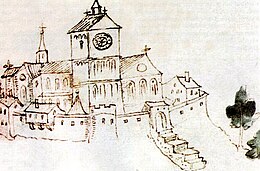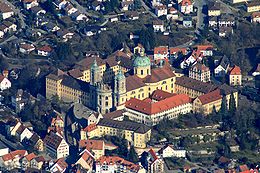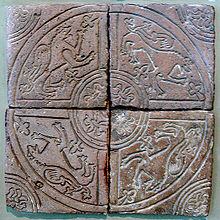Weingarten Abbey
|
Territory in the Holy Roman Empire |
|
|---|---|
| Weingarten Imperial Abbey | |
| coat of arms | |
 
|
|
| map | |

|
|
| Territory of the Imperial Abbey of Weingarten (upper center outlined in purple) (around 1800) | |
| Location in the Reichskreis | |
 (1572) (1572)
|
|
| Alternative names | Reichsstift |
| Arose from | ordinary abbey |
| Form of rule | Elective monarchy |
| Ruler / government | Reich Abbot |
| Today's region / s | DE-BW |
| Parliament | Reichsfürstenrat : 1 curiate vote on the Swabian prelate bank |
| Reich register | 4 glaives (1422); 4 horses, 18 foot soldiers, 120 guilders (1521); 4 on horseback, 18 on foot or 120 guilders (1663); 4 on horseback, 18 on foot or 120 guilders and 50 guilders to the Supreme Court (18th century) |
| Reichskreis | Swabian Empire |
| District council | County council: 8 on horseback, 36 on foot (1532) |
| Capitals / residences | Vineyard |
| Denomination / Religions | Roman Catholic |
| Language / n | German , Latin |
| surface | 6 square miles = 320 km² |
| Residents | 11,000 to 14,000 inhabitants |
| Incorporated into | 1803 Principality of Nassau-Oranien-Dillenburg ; 1806/08 shares in the Kingdom of Württemberg
|
The Monastery Weingarten (lat. Abbatia Vinea vel Abbatia Winigartensis ) is a former abbey of Benedictine (patronage. St. Martin of Tours and St.. Oswald of Northumbria ) on the Martinsberg in to 1865 "Altdorf" mentioned, named today after the monastery City of Weingarten in the southeast of Baden-Württemberg . The former home monastery of the Guelphs existed from 1056 until it was abolished by secularization in 1803. In 1922 the abbey was repopulated and belonged to the Beuron congregation . In autumn 2010 the abbey was closed and the last monks left the monastery.
history



The first monastery
In 1056 Welf IV founded a Benedictine monastery on Martinsberg , which was populated by monks from Altomünster . In return, the nuns from Altdorf Abbey, which was founded around 935 and burned down in 1053, settled Altomünster Abbey in 1055 .
In 1090 the Abbey was given the Holy Blood relic by Judith, wife of Welf IV . This relic is made from the soil of Mount Golgotha that is soaked in the blood of Jesus. In the following years, many people made donations to the monastery in order to honor the relic, including the country and entire villages and their inhabitants.
After 1088 the monastery achieved a first blooming phase through the connection with the Hirsau reform and in 1094 the right to the free election of abbots . The name "Weingarten" is documented around 1123. Between 1124 and 1182 the new monastery and an 86-meter-long Romanesque abbey church were built . At the same time, the Weingarten monastery school gained importance, as did the arts and crafts, the library, the scriptorium, but especially the illumination . Her most famous work is Abbot Berthold's Sacramentary from the first quarter of the 13th century, which is now in the Pierpont Morgan Library in New York .
The monastery was the burial place and home monastery of the Guelphs. Twelve members of the older Swabian Guelph line, who died between 990 and 1126, are buried in the Guelph crypt in today's basilica, including Welf II and Welf III. , Welf IV. , Welf V. and Henry the Black .
1178 sold Welf VI. his legacy north of the Alps to Emperor Friedrich I Barbarossa ; With this, the monastery came into possession of the Staufers and their bailiwick in 1179 or 1190.
The monastery was elevated to an imperial abbey in 1274 and confirmed by King Rudolf von Habsburg . Abbot Johannes Blarer (1418–1437) succeeded in reforming the convent and building a library in the early 15th century. From 1477 to 1487 the monastery church was rebuilt after a fire. In 1499 Austria temporarily occupied the abbey. Abbot Gerwig Blarer (1520–1567) was able to obtain imperial immediacy from Austria in 1533. Since 1555 the abbot of the monastery was one of the fixed representatives at an Ordinary Reich Deputation Day . Under Abbot Georg Wegelin (1587–1627), the "second founder", the permanent restoration of religious life in Weingarten was successful. The abbey was instrumental in founding the Upper Swabian Benedictine Congregation in 1603. After the Thirty Years' War, Weingarten maintained close relationships with the Salzburg Benedictine University . Abbots of the monastery worked in Salzburg as presides, professors and assistants. One of Weingarten's most important scholars was the Benedictine Gabriel Bucelinus . In 1671 he received papal permission to found the Weingarten Brotherhood of the Holy Blood .
The monastery was due to its large land holdings of 306 km² with around 11,000 inhabitants, which stretched from the Allgäu to central Lake Constance and included many forests and vineyards, one of the richest monasteries in southern Germany. Under Abbot Sebastian Hyller (1697–1730) the Romanesque monastery church, built from 1124 to 1182, was largely demolished from 1715; In its place, Franz Beer built a large, richly furnished, baroque abbey church in the years 1715–1724 . This received later from Pope Pius XII. in 1956 the papal honorary title Basilica (more precisely: Basilica minor ). It should stand in the middle of an ideal-typical monastery complex, which was built from 1727. However, the ideal plan of the monastery was only partially implemented.
In the course of secularization , the monastery and imperial abbey were dissolved in 1802 and initially owned by the House of Orange-Nassau , then part of the Kingdom of Württemberg in 1806 . The monastery buildings were used as a factory, an orphanage and until 1921 barracks .
Re-establishment in 1922
1922 Weingarten was repopulated by Benedictines from the Beuron Archabbey and the Abbey founded by Beuron in Erdington (now part of Birmingham , England). In 1936 there were 160 monks living in Weingarten, more than ever before. In 1940 the monks were expelled by the National Socialists ; after the end of the war the Benedictines were able to return to Weingarten; 25 of the monks drafted into the Wehrmacht had died. In the 1960s, almost 70 monks lived in the monastery again.
As early as 1922, the monks began to set up a natural history and ethnographic collection, some of which was housed in the monastery buildings and in the enclosure. Until the 1980s, the collection was steadily expanded and finally comprised over 20,000 items from the fields of mineralogy, paleontology, archeology, ethnology and zoology. After the dissolution of the monastery, the collection was placed in the care of the Museum Auberlehaus in Trossingen , where parts of the collection are permanently accessible, the majority is in storage and is available to interested laypeople and scientists as well as for special exhibitions.
In 1982 Lukas Weichenrieder took over the office of abbot. 23 monks left the monastery during his years in office. Some had lived there for ten to 20 years.
In addition to the solemn praise of God, the tasks of the abbey include pastoral care in the parish of St. Martin, the pilgrimage to the precious blood , the spiritual care of the monastery guests and the ecumenical movement with the Eastern Churches.
For a long time, Weingarten was a monastery with two ecclesiastical traditions ( "rites" ): some of the monks celebrated according to the Roman , some according to the Byzantine rite .
In 2004 Abbot Lukas Weichenrieder resigned from his office after 22 years, presumably because of internal disputes, and temporarily left the monastery. Subsequently, the monastery was headed by Archabbot Theodor Hogg from Beuron as abbot administrator, who in November 2004 appointed Father Martin Rieger as prior of the monastery. In November 2005, this surprisingly resigned from his position as pastor of the Weingarten Basilica parish of St. Martin and from his position as prior due to "personal reasons". Rieger also asked to be released from his monastic vows in order to take over a Catholic parish outside the Benedictine order. Father Pirmin Meyer was appointed the new prior. In 2007, Father Basilius Sandner from the Maria Laach Abbey was elected as the so-called Prior-Administrator, so he had all the rights and duties of an abbot, but not the benediction.
At the end of September 2009 it became known that the Benedictine monastery Weingarten should be closed. At that time, only four monks lived in the monastery, of which Father Anselm Günthör was the oldest and was 98 years old. Attempts to win new Benedictines failed. The Diocese of Rottenburg-Stuttgart entered the lease with the state of Baden-Württemberg as the successor to Weingarten Abbey. On October 16, 2010 the Benedictines left the monastery.
Use of the former monastery building
The monastery and church are a main attraction on the Upper Swabian Baroque Route . One wing of the abbey complex (with cloister) housed the newly settled Weingarten Benedictine monastery from 1922 to 2010. Other parts of the former monastery complex are used by the Weingarten University of Education and the Academy of the Rottenburg-Stuttgart diocese . The courtyards of the monastery were the scene of open-air performances of the Weingarten monastery festival in summer from 2000 to 2014 . The former enclosure of the monastery has served as refugee accommodation since 2013.
Monastery complex with basilica
The entire complex on Martinsberg in Weingarten is owned by the State of Baden-Württemberg.
basilica
→ See main article: St. Martin (Weingarten)
At 102 meters, the St. Martin Basilica is the longest baroque church in Germany, but also one of the largest and most monumental. It was modeled on St. Peter's Basilica on a scale of 1: 2. The construction of the church should only be the glamorous start of the Weingarten construction activity. According to the ideas of the abbot and convent, which were reflected in the ideal plan of 1723, the courtyard buildings (south of the church) should also be renewed.
As early as 1727, barely two and a half years after the church was consecrated, Abbot Hyller began building the building area north of the church (courtyard building). The builder was Joseph Schmuzer (1683–1752). First the east wing was built. But when they wanted to start with the north wing in 1728, the Innsbruck government objected to a report from the bailiff, claiming that the new building was leaving the monastery area and affecting the via regia (Reichsstraße).
On April 27, 1728 a building ban was issued. As a result, construction was continued in the south of the church and the east wing was completed in 1732 (seminar building, today: academy).
The ongoing construction work plunged the monastery into debt. Leopold Mozart mentions in a letter dated January 13, 1786 to his daughter Nannerl in St. Gilgen Abbot Anselm Rittler and, in connection with this, also the indebtedness of many monasteries.
In addition to its architecture, the Weingarten basilica is also famous for the Gabler organ , which was built between 1735 and 1750 by the organ builder Joseph Gabler from Ochsenhausen. It has 60 registers on 4 manuals and pedal, as well as 6666 pipes.
Since the six windows embedded in the west facade were not allowed to be covered during the organ building (similar to later in Neresheim ), Gabler had to develop an extremely complex construction and arrangement for the organ around the windows. The technical accomplishment of this project is still considered to be a masterpiece of organ building.
Munster forecourt
The cathedral forecourt borders the basilica to the west. At the southern end of its baroque facade there is a remnant of the Romanesque predecessor church. When it was demolished in 1715, the south wall of the right aisle was deliberately left standing in order to commemorate the old church, which had shaped life in the monastery for almost six hundred years since 1124.
Convention
The convent with cloister and enclosure is an area closed to the public that was reserved for monastic life until 2010. After the convention was closed, the diocese of Rottenburg-Stuttgart took over this part of the building as a tenant in July 2010. In May 2011, the priestly community of Sankt Martin expressed interest in taking over the former premises of the convent. From 2014 to 2016 the building served as an initial reception center for refugees.
academy
The Academy of the Diocese of Rottenburg-Stuttgart is home to conference rooms and guest houses.
patio
In the courtyard to the north of the basilica there has been a copy of the Brunswick Lion since 1999 . The heraldic animal of the Guelphs reminds us that Altdorf was the ancestral seat of this noble family from the 9th to the 11th centuries. The monument was donated by the Upper Swabian Electricity Works Association (OEW).
Pedagogical College
The Weingarten University of Education has housed its administration in the monastery complex. There are also lecture halls in this wing.
Rectory
The parsonage of the basilica parish also belongs to the monastery complex; this has been led since 2007 by a priest from the Rottenburg-Stuttgart diocese. For decades, a monk of the abbey was also the parish administrator of the parish .
Holy Blood Relic
The Holy Blood relic is a golden double cross set with 65 precious stones, with a glass tube as a core. The relic contains mixed with soil, according to tradition a drop of the blood of Jesus Christ and is part of Hl. Blood relic of Mantua. It does not belong to the Benedictine order and will remain in the basilica after the convention is closed. The relic is locked in a safe in the main altar. Up to three meters away, visitors to the basilica are allowed to step up to the Holy Blood Altar, which shows the Holy Blood relic lying on a red velvet cushion behind a pane of glass. It is carried annually on Blood Friday (after Ascension Day ) in an equestrian procession, the blood kick , through town and corridors. In the museum for monastery culture of the city of Weingarten, the rich history of the relic is shown, as well as the many forms of expression of veneration on the basis of devotional images, images of the Holy Blood and various devotional objects.
Oil consecrated by the relic is known as holy blood oil and is sold locally.
See also
- List of Abbots of Weingarten
- Weingartner song manuscript
- Sergiuschor Weingarten
- Gabriel Bucelinus
- Gerhard Hess (historian)
literature
- Norbert Kruse and a. (Ed.): Weingarten from the beginning to the present . Biberacher Verlagsdruckerei, Biberach / Riß 1992, ISBN 3-924489-61-0 (on the town and monastery history)
- Norbert Kruse, Hans Ulrich Rudolf (ed.): 900 years of adoration of the Holy Blood in Weingarten 1094–1994 . 3 volumes. Thorbecke, Sigmaringen 1994, ISBN 3-7995-0398-6
- Sönke Lorenz : Weingarten and the Welfs , in: Dieter R. Bauer , Matthias Becher (Hrsg.): Welf IV. - Key figure of a turning point. Regional and European perspectives (= magazine for Bavarian national history, supplement. Series B, 24), Munich 2004, ISBN 3-406-10665-X , pp. 30–55
- Hans Ulrich Rudolf, Anselm Günthör: The Benedictine Abbey Weingarten between its founding and the present. An overview of 950 years of monastery history 1056–2006 . Fink, Lindenberg 2006, ISBN 3-89870-292-8
- Gebhard Spahr , Columban Bulh: Festschrift for the 900th anniversary of the monastery 1056–1956. A contribution to the intellectual and property history of the abbey . Weingarten Abbey, Weingarten 1956
Web links
- Benedictine Abbey Weingarten in the database of monasteries in Baden-Württemberg of the Baden-Württemberg State Archives
References and comments
- ↑ a b c d e f g h i j Stefan Hilser, Andrea Fritz: Monastery complex with history: Today a pilgrimage site and educational institution . In: Südkurier of April 10, 2010
- ^ Josef Tutsch: Long-lasting organization with reform backlog. In: scienzz.de. August 29, 2006, accessed January 3, 2014 .
- ↑ from 1868 infantry regiment "Kaiser Wilhelm, King of Prussia" (2nd Württembergisches) no. 120 , from 1898 infantry regiment "König Wilhelm I" (6th Württembergisches) no. 124 , 1919–1920 Reichswehr
- ↑ Ulla Franziska Lang: The Passion of the Monks. Südkurier, April 10, 2010, accessed January 3, 2014 .
- ↑ Weingarten Monastery has to close. Retrieved March 8, 2020 .
- ↑ Catholic church rents Benedictine monastery in Weingarten. December 21, 2009, accessed January 3, 2014 .
- ↑ Ursula Ott u. a .: Man, that was quick! . In: chrismon plus 2/2016. ISSN 1619-6384, pp. 56-63.
- ↑ In the empire, in Bavaria, and in other countries, learned prelates put the monasteries into debt and brought them into disorder . Wilhelm A. Bauer / Otto Erich German: Mozart. Letters and Notes . Kassel u. a. 1963, Vol. III, No. 918, lines 40f.
- ↑ Dirk Grupe: Blood Friday in Weingarten. The monastery closes and the heart stands still . In: Schwäbische Zeitung from May 12, 2010
Coordinates: 47 ° 48 ′ 33.2 " N , 9 ° 38 ′ 41.2" E





